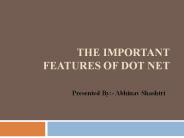SAFE-T NET - PowerPoint PPT Presentation
Title:
SAFE-T NET
Description:
Induction & Mentoring. Formal. Evaluation. GBE. 5. ADEPT. Assisting ... induction/mentoring and GBE (i.e., the 'assisting and developing' processes) are ... – PowerPoint PPT presentation
Number of Views:84
Avg rating:3.0/5.0
Title: SAFE-T NET
1
SAFE-T NET Introduction
www.scteachers.org
2
ADEPT is the acronym for . . .
A
ssisting,
D
eveloping, and
E
valuating
P
rofessional
T
eaching
3
Which of the three ADEPT verbs is least like the
other two?
Assisting
Developing
Evaluating
4
ADEPT Continuum
GBE
Formal Evaluation
Induction Mentoring
Teacher Preparation
5
Teacher Preparation
Induction Mentoring
Formal Evaluation
GBE
Assisting Developing
Evaluating
6
Formative (AD) Summative (E)
Goal
Focus
Perspective
Stakes
Frequency
Feedback
Improvement
Judgment
Process
Outcome
Specific
Holistic
Lower
Higher
Ongoing
Periodic
Descriptive
Rating
7
- When the chef tastes the soup, thats
___________. - When the customers taste the soup, thats
___________.
formative
summative
8
In terms of the ADEPT processes,
- induction/mentoring and GBE (i.e., the assisting
and developing processes) are _____________. - formal evaluation (i.e., the evaluating
process) is ______________.
formative
summative
9
ADEPT Foundation
Performance Standards
10
ADEPT Performance Standards
- The ADEPT Performance Standards are statements
of what teachers should know and be able to do to
be effective (that is, to positively influence
student learning).
11
Currently, there are ADEPT Performance Standards
for which four groups of educators?
- Classroom-based teachers
- Library media specialists
- School guidance counselors
- Speech-language therapists
12
Who are classroom-based teachers?
- Teachers of core content subjects
- Teachers of related subjects (e.g., physical
education, career and technology education) - Teachers of special education
13
Into what categories do we classify effective
teaching?
Domains
Performance Standards
Key Elements
14
What are the four domains for classroom-based
teachers?
- Planning
- Instruction
- Environment
- Professionalism
15
Which standards fall under the PLANNING domain?
- APS 1 Long-Range Planning
- APS 2 Short-Range Planning of Instruction
- APS 3 Planning Assessments and Using Data
16
Which standards fall under the INSTRUCTION domain?
- APS 4 Establishing Maintaining High
Expectations for Learners - APS 5 Using Instructional Strategies to
Facilitate Learning - APS 6 Providing Content for Learners
- APS 7 Monitoring, Assessing, Enhancing
Learning
17
Which standards fall under the ENVIRONMENT domain?
- APS 8 Maintaining an Environment That Promotes
Learning - APS 9 Managing the Classroom
18
Which standard falls under the PROFESSIONALISM
domain?
- APS 10 Fulfilling Professional Responsibilities
19
Domains and APSs
Planning APS 1 APS 2 APS 3
Professionalism APS 10
Instruction APS 4 APS 5 APS 6 APS 7
STUDENT ACHIEVEMENT
Environment APS 8 APS 9
20
What is the purpose of the key elements?
- The key elements define the most important
aspects or components of each ADEPT Performance
Standard.
21
Key Elements
The descriptions and examples that follow each
key element are not intended to be transformed
into ________________!
checklists
22
How many key elements are there in all?
- Do the key element math
- APS 1 and APS 10 each contain 5 key elements.
- The other eight ADEPT performance standards each
contain 3 key elements.
34
23
In summary,
- effective teaching for classroom-based
teachers is defined by - 4 domains,
- 10 performance standards, and
- 34 key elements.
24
Further. . .
- These domains, standards, and key elements
apply to classroom-based teachers throughout
their career continuumsfrom pre-professional
preparation through full retirement from the
teaching profession.
25
Key Element Sort
26
Homework
27
SAFE-T
www.scteachers.org
28
SAFE-T is the acronym for
S
ummative
A
DEPT
F
ormal
E
valuation of
T
eachers
29
Training Goal
- The goal of this SAFE-T Evaluator Training is
to ensure that each of you becomes a
________SAFE-T evaluator.
trusted
30
Who needs to be able to trust you?
- The teachers who are being evaluated
- Your school district
- Institutions of higher education (IHEs)
- The state
- Your colleagues in the profession
31
What is SAFE-T trust?
- You are professionally competent and qualified to
serve as an evaluator. - You will follow the standardized procedures for
implementing the SAFE-T process. - You will complete all requirements in a
responsible and timely manner. - You will respect the teachers you evaluate as
well as the other members of your team.
32
What is SAFE-T trust?
- You will act with honesty and integrity.
- You will make your decisions in an unbiased and
objective manner. - You will maintain confidentiality.
- You will report any procedural violations or
conflicts of interest.
33
What does SAFE-T do?
- SAFE-T replaces the original ADEPT formal
evaluation models for classroom-based teachers
(e.g., TEAM, STEP, FEAT, TEP).
34
What makes SAFE-T a formal evaluation?
- SAFE-T involves standardized procedures and
criteria.
What makes SAFE-T summative?
SAFE-T results are highly consequential.
35
SAFE-T results are used to make
- state-level decisions (e.g. certificate
advancement sanctions against certificates) - district-level decisions (e.g., continuation of
employment contract level eligibility), and - decisions about the effectiveness of teacher
preparation (e.g., IHEs, PACE)
36
Additionally,
- SAFE-T results become a permanent part of each
teachers professional performance record (i.e.,
the teachers ___________ ___________).
ADEPT
history
37
How is evaluation defined?
- Evaluation refers to the process of making
informed judgments based on - the criteria (i.e., the domains, performance
standards, and key elements) and - the evidence of teacher performance.
38
Evaluation
- All evaluation processes rely on behavior
sampling. - SAFE-T samples the teacher behaviors that are
believed to be the most likely to yield valid
judgments of teacher effectiveness.
39
SAFE-T Keys
- SAFE-T parallels the American system of
justice. - So, if, in the judicial system, the defendant is
innocent until proven guilty, then - in SAFE-T, the teacher is competent unless
_________________.
proven otherwise
40
SAFE-T Keys
- Evaluators are to take a _________ view of
teachers before they engage in an analytical
review of the teaching performance.
holistic
41
Helpful Advice
- Make your
- SAFE-T Guide
- your new best friend!
42
What are the stages of the SAFE-T process?
- Stage I Preparation
- Stage II Collection of evidence
- Stage III Deliberation
- Stage IV Judgments
43
SAFE-T Stage I ___________Reminders
Find it in your SAFE-T Manual. . . .
Preparation
classroom-based teachers only
- SAFE-T is for_________________________.
- When SAFE-T is used for certificate/contract
advancement purposes, - teachers must be evaluated only in an area or
areas in which they are certified at the time of
the evaluation, and - teachers must be employed at least half-time (FTE
gt 0.5)
44
SAFE-T Stage I ___________
Find it in your SAFE-T Manual. . . .
Preparation
- Step 1
- The district establishes its annual evaluation
timeline.
45
What is the minimum number of days for SAFE-T?
- SAFE-T must cover a minimum of 90 student
attendance days over the course of a single
academic year.
46
What are the requirements for evaluation periods?
- SAFE-T must consist of two evaluation periods
(also referred to as evaluation cycles) that are
roughly equal in length (i.e., approximately 45
working days each).
47
What is the timeline for each evaluation period?
- The entire preliminary (i.e., first) evaluation
period must occur during the first semester of
the school year. - At least a portion of the final (i.e., second)
evaluation period must occur during the second
semester of the school year.
48
When does SAFE-T begin and end?
- The preliminary evaluation period begins on or
after the date the teacher orientation is held. - The final evaluation period ends on the date that
all final evaluation conferences must be
completed, but must end before the date contracts
must be issued.
49
SAFE-T Stage I Preparation
- Step 2
- An ADEPT evaluation team is appointed for each
teacher who is scheduled to undergo SAFE-T.
50
What are the evaluation team membership
requirements?
- Each team must consist of a minimum of two
trained and appropriately qualified evaluators. - One of the members must be designated to serve as
the team chair.
51
What are the evaluation team membership criteria?
- A minimum of three evaluators is required for
teachers undergoing highly consequential formal
evaluations.
52
What is a highly consequential evaluation?
- A highly consequential evaluation applies to
any annual-contract teacher who - has failed annual-formal 1 and is now undergoing
annual-formal 2 - or
- is returning to teaching following an
ADEPT-related certificate suspension.
53
SAFE-T Stage I ___________
Preparation
- Step 3
- Each teacher receives a comprehensive orientation
to the SAFE-T process.
54
SAFE-TQuestions andTake-Aways
(So far. . . )































